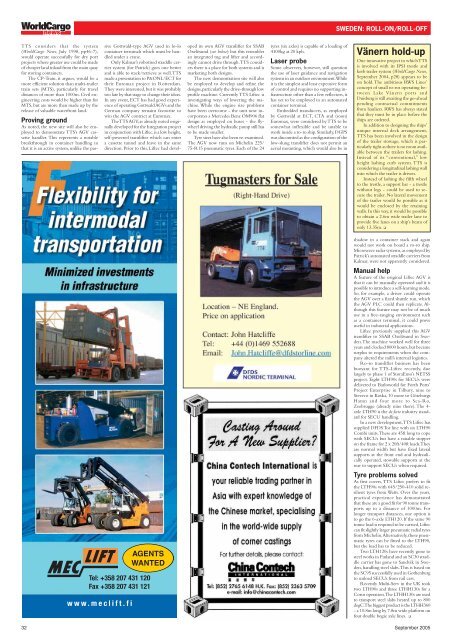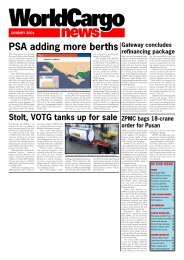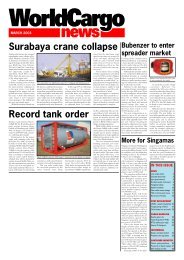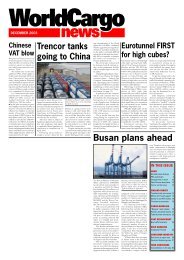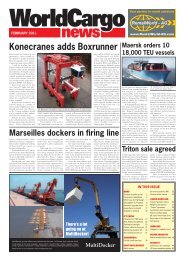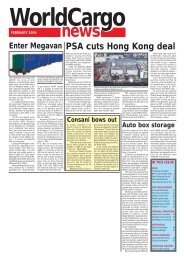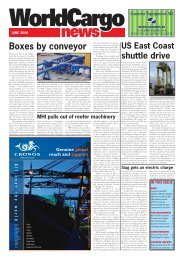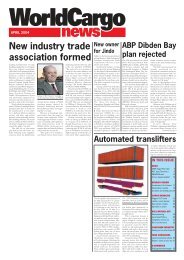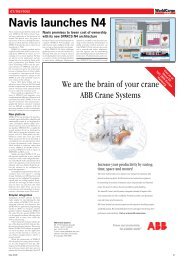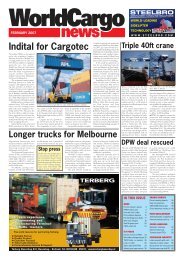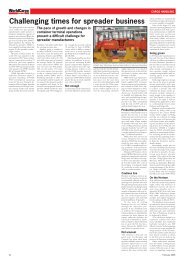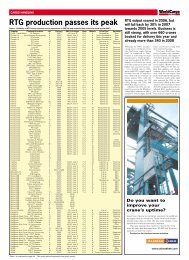US-built box crane - WorldCargo News Online
US-built box crane - WorldCargo News Online
US-built box crane - WorldCargo News Online
Create successful ePaper yourself
Turn your PDF publications into a flip-book with our unique Google optimized e-Paper software.
<strong>WorldCargo</strong><br />
news<br />
SWEDEN: ROLL-ON/ROLL-OFF<br />
TTS considers that the system<br />
(<strong>WorldCargo</strong> <strong>News</strong>, July 1998, pp46-7),<br />
would operate successfully for dry port<br />
projects where greater use could be made<br />
of cheaper land inland from the main quay<br />
for storing containers.<br />
The CP-Train, it argues, would be a<br />
more efficient solution than multi-trailer<br />
train sets (MTS), particularly for travel<br />
distances of more than 1000m. Civil engineering<br />
costs would be higher than for<br />
MTS, but are more than made up by the<br />
release of valuable waterfront land.<br />
Proving ground<br />
As noted, the new site will also be employed<br />
to demonstrate TTS’s AGV cassette<br />
handler. This represents a notable<br />
breakthrough in container handling in<br />
that it is an active system, unlike the passive<br />
Gottwald-type AGV used in lo-lo<br />
container terminals which must be handled<br />
under a <strong>crane</strong>.<br />
Only Kalmar’s robotised straddle carrier<br />
system (for Patrick) goes one better<br />
and is able to stack/retrieve as well. TTS<br />
made a presentation to P&ONL/ECT for<br />
their Euromax project in Rotterdam.<br />
They were interested, but it was probably<br />
too late by that stage to change their ideas.<br />
In any event, ECT has had good experience<br />
of operating Gottwald AGVs and the<br />
German company remains favourite to<br />
win the AGV contract at Euromax.<br />
The TTS AGV, as already noted originally<br />
developed for the Integration project<br />
in conjunction with Liftec, is a low height,<br />
self-powered translifter which can enter<br />
a cassette tunnel and leave in the same<br />
direction. Prior to this, Liftec had developed<br />
its own AGV translifter for SSAB<br />
Oxelösund (see below) but this resembles<br />
an integrated tug and lifter and accordingly<br />
cannot drive through. TTS considers<br />
there is a place for both systems and is<br />
marketing both designs.<br />
The new demonstration site will also<br />
be employed to develop and refine the<br />
designs, particularly the drive-through low<br />
profile machine. Currently TTS Liftec is<br />
investigating ways of lowering the machine.<br />
While the engine size problems<br />
have been overcome - the unit now incorporates<br />
a Mercedes Benz OM906 flat<br />
design as employed on buses - the flywheel<br />
driving the hydraulic pump still has<br />
to be made smaller.<br />
Tyre sizes have also been re-examined.<br />
The AGV now runs on Michelin 225/<br />
75-R15 pneumatic tyres. Each of the 24<br />
tyres (six axles) is capable of a loading of<br />
4100kg at 20 kph.<br />
Laser probe<br />
Some observers, however, still question<br />
the use of laser guidance and navigation<br />
systems in an outdoor environment. While<br />
it is the simplest and least expensive form<br />
of control and requires no supporting infrastructure<br />
other than a few reflectors, it<br />
has yet to be employed in an automated<br />
container terminal.<br />
Embedded transducers, as employed<br />
by Gottwald at ECT, CTA and (soon)<br />
Euromax, were considered by TTS to be<br />
somewhat inflexible and be unable to<br />
work inside a ro-ro ship. Similarly, DGPS<br />
was discounted as the configuration of the<br />
low-slung translifter does not permit an<br />
aerial mounting, which would also be in<br />
Vänern hold-up<br />
One innovative project in which TTS<br />
is involved with its IPSI trestle and<br />
kerb trailer system (<strong>WorldCargo</strong> <strong>News</strong>,<br />
September 2004, p28) appears to be<br />
on hold. The ambitious RWS Lines’<br />
concept of small ro-ros operating between<br />
Lake Vänern ports and<br />
Duisburg is still awaiting the go-ahead<br />
pending contractual commitments<br />
from hauliers. RWS has always stated<br />
that they must be in place before the<br />
ships are ordered.<br />
In addition to designing the ships’<br />
unique internal deck arrangement,<br />
TTS has been involved in the design<br />
of the trailer stowage, which is particularly<br />
tight as there is no room available<br />
between the trailers for lashing.<br />
Instead of its “conventional,” low<br />
height lashing curb system. TTS is<br />
considering a longitudinal lashing wall<br />
into which the trailer is driven.<br />
Instead of lashing the fifth wheel<br />
to the trestle, a support bar - a trestle<br />
without legs - could be used to secure<br />
the trailer. No lateral movement<br />
of the trailer would be possible as it<br />
would be enclosed by the retaining<br />
walls. In this way, it would be possible<br />
to obtain a 2.6m wide trailer lane to<br />
provide five lanes on a ship’s beam of<br />
only 13.35m. ❏<br />
Tel: +358 207 431 120<br />
Fax +358 207 431 121<br />
www.meclift.fi<br />
AGENTS<br />
WANTED<br />
shadow in a container stack and again<br />
would not work on board a ro-ro ship.<br />
Microwave radar systems, as employed by<br />
Patrick’s automated straddle carriers from<br />
Kalmar, were not apparently considered.<br />
Manual help<br />
A feature of the original Liftec AGV is<br />
that it can be manually operated and it is<br />
possible to introduce a self-learning mode.<br />
So, for example, a driver could operate<br />
the AGV over a fixed shuttle run, which<br />
the AGV PLC could then replicate. Although<br />
this feature may not be of much<br />
use in a free-ranging environment such<br />
as a container terminal, it could prove<br />
useful in industrial applications.<br />
Liftec previously supplied this AGV<br />
translifter to SSAB Oxelösund in Sweden.<br />
The machine worked well for three<br />
years and clocked 8000 hours, but became<br />
surplus to requirements when the company<br />
altered the mill’s internal logistics.<br />
Ro-ro translifter business has been<br />
buoyant for TTS-Liftec recently, due<br />
largely to phase 1 of StoraEnso’s NETSS<br />
project. Eight LTH90s for SECUs were<br />
delivered to Barloworld for Forth Ports’<br />
Project Enterprise in Tilbury, nine to<br />
Steveco in Kotka, 10 more to Göteborgs<br />
Hamn and four more to Sea-Ro,<br />
Zeebrugge (already nine there). The 4-<br />
axle LTH90 is the de facto industry standard<br />
for SECU handling.<br />
In a new development, TTS Liftec has<br />
supplied DFDS Tor line with six LTH90<br />
Combi units. These are 45ft long to cope<br />
with SECUs but have a raisable stopper<br />
on the frame for 2 x 20ft/40ft loads. They<br />
are normal width but have fixed lateral<br />
supports at the front end and hydraulically<br />
operated, stowable supports at the<br />
rear to support SECUs when required.<br />
Tyre problems solved<br />
As first covers, TTS Liftec prefers to fit<br />
the LTH90s with 645/250-410 solid resilient<br />
tyres from Watts. Over the years,<br />
practical experience has demonstrated<br />
that these are a good fit for 90 tonne transports<br />
up to a distance of 1000m. For<br />
longer transport distances, one option is<br />
to go the 6-axle LTH120. If the same 90<br />
tonne load is required to be carried, Liftec<br />
can fit slightly larger pneumatic radial tyres<br />
from Michelin. Alternatively, these pneumatic<br />
tyres can be fitted to the LTH90,<br />
but the load has to be reduced.<br />
Two LTH120s have recently gone to<br />
steel works in Finland and an SC30 straddle<br />
carrier has gone to Sandvik in Sweden,<br />
handling steel slabs. This is based on<br />
the SC95 successfully used in Gothenburg<br />
to unload SECUs from rail cars.<br />
Recently Multi-Serv in the UK took<br />
two LTH90s and three LTHH130s for a<br />
Corus operation. The LTHH130s are used<br />
to transport steel slabs heated up to 800<br />
degC. The biggest product is the LTHH360<br />
- a 10.8m long by 7.8m wide platform on<br />
four double bogie axle lines. ❏<br />
32<br />
September 2005


